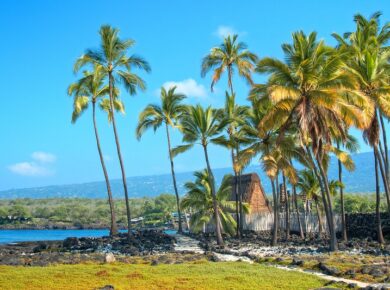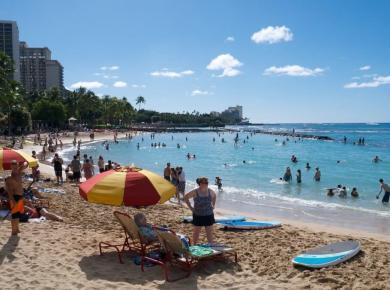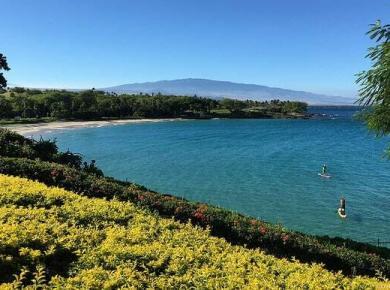It was humbling and mesmerizing experience to watch lava flowing into the ocean. I struggle to find the adequate words to describe it. If you are able to get out to the Big Island to see if for yourself, then I strongly encourage you to do so.
I wanted to share some tips for viewing the lava so that you can make the most of your experience. Here are my suggestions.
When to Go
Try as best as you can to see the lava around sunset and afterwards or before sunrise. The sun’s rays wash out the incandescence of the lava, so you can’t really see as much of it in the daytime. The following image illustrates the dramatic difference between daylight and dusk lava viewing. After dusk, the contrast is even more dramatic.
We were able to see the lava during daylight hours and then at sunset and about an hour afterwards. We were fortunate enough to see the contrast of daytime viewing and nighttime viewing. There really is a huge difference in what you can see.
Assuming lava is visible from the Hawaii County lava viewing point, if you go to see the lava just before sunset, you’ll be able to walk to the lava viewing point more safely in the daylight hours. When lava is active at the Hawaii County lava viewing point, the site opens to the public at 2pm and closes at 10pm. Entry is not allowed to past 8pm.
Where to Find the Lava
Kilauea Volcano is quite active and almost always on the move. Active, red lava is sometimes easy to access and view and sometimes not. You cannot predict exactly where the lava will be weeks or months or years from now. See this collection of useful links to help you find out what’s going on with the active lava flow. Through those resources, you will be able to find out where the lava has been active within the most recent 24 hours.
What to Wear
– One of the most important things to wear is shoes with a rugged sole and good gripping tread, such as hiking shoes. A trail running trainer would also work. You’ll be trekking over very uneven surfaces (hardened lava) and a shoe with a firm or semi-firm sole will help you keep your balance. I observed a few people wearing flip flops and dress/street shoes and they had a very difficult time walking. I wore my hiking shoes and I was so glad I did. Andy wore his Keens, which also worked fine because we did not get close enough to the lava activity to feel the heat. If you’ll be very close to the actual flow and/or walking over fresh lava, which we don’t advise, a hiking shoe with a good sole will protect your feet from the heat.
– If you’ll be seeing the lava during day light hours then be sure to wear sunscreen and a hat or visor. Sunglasses are also helpful.
– You should try to wear long trousers to protect your legs if you fall. Hardened lava can be sharp as glass and quite dangerous if you fall. I wore a light weight hiking trousers.
– One reader, Ben, advises to wear gloves to protect your hands should you fall. Pick up a pair of work gloves from the dollar store.
What to Bring
– Water is a must! If you’ll be going to see the lava in the daytime, bring extra water. It’s amazing how much hydration you need when you’re walking over black lava with no shade.
– Snacks or energy bars may come in handy. There are no restaurants in the area.
– Flashlight for finding your way in the dark. The county has installed some reflective poles and some yellow tape on the ground to help you navigate to and from the viewing point.
– Binoculars will help you get a closer view. You may be a couple of hundred yards or more from the lava.
– Cameras with well charged batteries and plenty of memory or film. Near the water, it’s quite windy, so if you have a tripod, do bring it
– A hiking stick or pole helps to keep you steady over uneven terrain.
– Sunscreen and lip balm with sun protection. Generally, there’s no shade in the lava flow areas.
– A hat or visor is useful to help protect your eyes and face from the sun.
– Your eyes will appreciate sunglasses, especially if you must hike over black lava fields in the daytime. Polarized lenses are particularly good to reduce eyestrain.
– Wet wipes. (There are port-a-johns, but no way to clean your hands.)
– If you have long hair, you may want to bring something to tie it back because it can be very windy near the ocean.
– Band-Aids and antibiotic ointment, in case you fall.
– Depending on where you’ll be going, you may want to have some mosquito repellant. After viewing the lava in the daytime, we walked back to our car to escape the sun and sit on cushioned chairs while we waited for sunset. We rolled down the windows and ended up getting some mosquitos in the car. Luckily we had our mosquito repellant with us.
Other Important Considerations
– Be aware of the many dangers of being around active lava. (Mahalo to Angie for the link.)
– Obey all signs and instructions provided by the county employees. (Hey, how about thanking them for establishing this viewing point for visitors to see.)
– Lock your car doors and put valuables out of sight.
– If you are thinking of going to see the lava from the West side of Hawaii, then plan on about a 2.5 hour one way drive.
– Finally, enjoy this rare and awesome display!
—-
See more ideas of vacation activities on Hawaii’s Big Island.








42 comments
Stay on the trail! – We have lost several people who tried to take a “Short Cut” back to the car. This poor guy He got lost out in the lava fields for five days and was featured on a TV show called something like “I should not be alive”. After about three days, he walked about 10 miles across the lava trying to get to where the helicopters were flying. He found small amounts of water here & there but, he had to stop because his brand new running shoes were shredded and the lava was cutting into his feet with almost every step.
Be careful near the waters edge. The lava looks solid but it frequently breaks off in large pieces or collapse into the ocean. Move inland quickly if you hear cracking, booming sounds or other unusual noises.
Hey Dave – thanks for your comments. Whoa…that dude really got himself lost. Eek! With the set up at the current flow, it would be sort of hard to get yourself lost, but I guess it could happen.
Last year a 16 acre lava delta fell into the ocean on the Big Island. That must have made a slight splash. 😉
You can watch some pretty cool time lapse video showing a 2005 lava delta colapse on this site: http://hvo.wr.usgs.gov/gallery/kilauea/volcanomovies/#oceanentry
Great article! See, I told you it’s mesmerizing! Nothing like it. I saw the show Dave referred to which is one of the reasons we ALWAYS carry a small mirror with us and we even have white reflective tape for the black lava but the most important thing we carry with us on any hike is our GPS. We’re geocachers so we have it with us for that but we always mark where we parked on the GPS so we can always find our car. (And of course tons of batteries for it) Mahalo for a great article!
Thank you Angie for your comment and kind words!
We’re kind of lucky right now in that the path to the official viewing is very well defined on each side, so it would be really, really hard to get lost. As you walk towards the ocean, there’s thick shrubs on the right and left. County employees are stationed along the way to keep you pointed in the right direction with flashlights at night.
We’re lucky that it’s also a very short hike now. I believe it’s only about 3/4 of a mile.
Are you going to be able to get out to this flow? We overheard a gentleman say that that he has been coming to the Big Island for over 10 years in a row and this particular lava viewing was the most spectacular he’d seen yet. We were really glad to hear that since we’d been unlucky in the past for lava viewing.
I would give anything to get out there right now to see this flow, it looks amazing but hubby’s work schedule doesn’t let up until Sept. 🙁 But the times we saw lava were flows that had lasted months so we’re keeping our fingers crossed that the volcano keeps doing its thing for that long though be both agreed if fountaining ever became involved as it was in the 80’s then we’re on the first plane there! LOL
Haha! I hear ya about the fountaining! I do hope you’ll get to see the flow later this year when your schedule permits.
I just had to cancel a trip to the Big Island at the last minute, but the airline will let me use my tickets some other time. I’m really hoping to make the trip while Pele is putting on such a spectacular show!
Mahalo for participating in the Carnival of Aloha!
Hi Skeet – I hope you get out to the Big Island to see it. It really is amazing!
Nice picture.
Not sure “One reader, Ben, advises to wear gloves to protect your hands should you fall. Pick up a pair of work gloves from the dollar store.” will help much
Amazing
We went on 10/4/2009 it was awesome.We were 3/4 of a mile from the flow and it was spectacular. Easy 20 min hike to the viewing area,it is well marked but a flashlight is mandatory for the trip back.try not to get distracted when walking as the terrian is very uneven and you will fall if not 100% focused.My ankle still hurts from twisting it when aperson talked to me and I answered her not paying attention to where I was going..But well worth it.A must see
Ken – great to hear you got to see such an amazing sight, despite the injury. Hope you heal soon!
We went to the Big Island in February 2009 and we only were able to see a large cloud of steam from a distance and we wanted to hike to the surface flows but the people at the viewing area said that we couldn’t get any closer. Now I know that they knew best but Ive seen hundreds of pictures of up-close surface flows.
We’re going back this October and I wanted to know if we would get to see the lava flow this time around, if they actually stopped letting people hike to it or if that was just a temporary precaution. Can someone please help me out?
Daniel – it all depends on if and where the lava is flowing. The Kilauea lava flow has moved dozens of times.
Did you see my post last week? Lava is once again on the move.
As your trip gets nearer, check out this post on how to find out what’s going on with the lava: https://govisithawaii.com/2009/10/07/how-to-find-out-whats-going-on-with-the-lava-on-hawaiis-big-island/
Lava was flowing when I visited but I was only able to see it up on the pali way off in the distance from a viewing area and I was extremely disappointed with that after seeing pictures and videos of people just a few feet from the lava. I was also disappointed because I read that you could hike right to the surface flows from multiple guide books. I would love to go back and see it, but only if theres more to see than just a tiny orange spot miles away.
That’s misleading for guidebooks to say you can just hike up to the lava flow. While that may be true at times, it is NOT always the case.
See the lava flow depends one where and how it’s flowing and that is very, very unpredictable.It’s impossible to say where and how the lava might be flowing next week,next month, etc.
Well thank you Sheila, hopefully my next visit will be more exciting than the last but I really do appreciate your words and time. Mahalo!
Daniel – I’ll keep my fingers crossed for you.
Your comment triggered my memory of our first visit to try to see the lava in 2004. Like you we had read that you could hike to see the lava and we saw these amazingly close photos of oozing lava. Well, our experience that time was much worse than yours. While technically we could have hiked to get a closer view of the lava….get this… it was an 18-mile round-trip hike across rugged terrain. While we love hiking, that was way more than we cared to do. We ended up having to take a helicopter tour that hovered briefly over Pu’u O’o just for a glimpse of a small sliver of red lava. So, I understand what it’s like to be disappointed that the lava doesn’t look like the things the glossy brochures and guide books tell you.
Daniel – not to pour salt on our wounds, but check out the recent lava video that I posted today https://govisithawaii.com/2010/02/18/another-great-volcanochaser-lava-video/ If I had a crystal ball, I’d bet it would say this flow has a good chance of continuing to the ocean and hopefully be flowing while you are there.
One thing to bear in mind with these surface flows is that once they get a flow to the ocean established, the lava starts to form tubes, so the surface flow ceases, but there should be a spectacular ocean entry.
Hi Sheila, I don’t mean to bother you but do you have any new info about the lava flows? Ive looked at the links you’ve posted but I’m having a hard time accessing whether or not to give the lava viewing another shot and thought I’d ask for your opinion if you get the chance, Thanks!
Daniel –
Unfortunately, I don’t know anything beyond what’s posted on the Kilauea update here: http://volcanoes.usgs.gov/hvo/activity/kilaueastatus.php
Per that site, here’s the lava viewing update:
Kalapana Public Access Information from Hawai`i County Civil Defense: Kalapana Gardens is a private subdivision and access will only be granted to subdivision residents. Private property borders highway 130 through Kalapana, and visitors to the Hawai`i County Lava Viewing Area are not allowed access off the highway easement. Hawai`i County Police will be monitoring the area. Hawai`i County Lava Viewing Area status can be found at 808 961-8093.
Maps, photos, Webcam views, and other information about Kilauea Volcano are available at http://volcanoes.usgs.gov/hvo/activity/kilaueastatus.php. A daily update summary is available by phone at (808) 967-8862.
—–
I recommend you call those phone numbers listed in the official update to ask for the most recent viewing information.
I subscribe to this youtube channel: http://www.youtube.com/profile?user=LAVALOVERBO#g/u The guy that uploads those videos lives there in Kalapana Gardens. His recent videos have shown some amazing flows, but I suspect he’s accessing areas that are beyond the safety of the Hawaii County Lava Viewing area.
Hope that helps.
Daniel – here’s another video from the gentleman that lives beside the lava flow: http://www.youtube.com/watch?v=dBPTc-n-pTI&feature=youtube_gdata
He says, “Lava is burning up more of our road at the public viewing area in Kalapana on the Big Island of Hawaii.”
It must be a pretty spectacular view!
Sheila,
How do I get to the area where photos like these were taken? http://hvo.wr.usgs.gov/kilauea/update/images.html
I’ve also seen photos where lava is on a black sand beach taken very recently. How do I get to those areas for photos?
Coming to the Big Island on Tuesday with first-timers and heard the ocean entry wasn’t quite active, but want to get them to some lava nonetheless. Please help.
Jay –
Based on the recent HVO reports, you can see lava flowing down the pali (hill) at the lava viewing point that’s located at the end of Highway 130 in Kalapana.
The photos in the link are in Royal Gardens. I doubt there is a specific trail there and don’t really advise going there without knowing the terrain very, very well. It’s easy to get lost, dehydrated, and disoriented.
The lava at a black sand beach — are you talking about moving lava or hardened old lava flows?
Keep an eye on the resources referenced in this post: https://govisithawaii.com/2009/10/07/how-to-find-out-whats-going-on-with-the-lava-on-hawaiis-big-island/ Also, make sure you visit the Hawaii Volcanoes National Park for their up to date advice.
Try also to see if Halemaumau crater is glowing at night from the embedded lava lake.
Just curious if anyone knows how far/long the hike is to/from the lava? We are trying to decide if we will have time to do it before returning to our cruise ship to depart at 6:00 pm.
Anne – I hope this reply gets to you in time for your cruise. (I’ve been out of town for the last 3 weeks and I’m just now catching up.)
The Kilauea Eruption Update page that Hawaii county operates used to provide a map indicating the trails, but they don’t have it anymore. My advice would be to call their hotline (808) 961-8093 and ask close to the time you’ll be there. Since the flows can and sometimes do move, it can be a little bit of a moving target.
Can anyone advise on the best place to view the lava flow with young children? I don’t think the hiking sounds very suitable for kids but I would really like them to experience it. I have a 2yr old and 5yr old and I’m guessing the terrain is not suitable for a stroller!
Any help would be much appreciated. We will arrive on Big Island on 21st August.
Thank you!
Fizza – at the moment, there’s really no other alternative other than the county viewing area.
You might want to consider that volcanic fumes can be hazardous for young children. This sign is posted at the lava viewing area. http://www.flickr.com/photos/govisithawaii/2335958900/
There is a boat tour offered by the folks at Lava Ocean Adventures http://www.lavaocean.com/ It can be a bit of a rocky ride. You might call to see if you think it might match your needs. 808.966.4200
Thanks Sheila
I called Lava Ocean Adventures and they won’t even consider taking anyone under 6yrs – which is completely understandable since they don’t have seatbelts on the boat. Can you tell me is there some way to stop the fumes being inhaled? Some mask of some sort? I’d really like to go to the volcanoes and that means taking the kids but I don’t want to put them at risk.
Frizza – there probably are masks, but unfortunately I don’t have any information on them.
It might be worth your while to speak to someone at the visitors center of Hawaii Volcanoes National Park. Maybe they have some ideas.
Another alternative might be to go on a helicopter tour, but I’m not sure if they would have a minimum age restriction. Safari Helicopters is offering a good deal that I blogged about in today’s post. They have a great safety record.
Is this the kind of thing that is doable with small kids…say 4, 6, and 8?
Chris — I’m not a physician or a volcanologist or park ranger, so I’m not qualified to make a definitive call on that. Lava viewing can be so variable depending on where it is at the time. Sometimes it could be perfectly fine to take a 4 year old, other times, I definitely wouldn’t advise it.
Consider that sometimes, you have to hike over old hardened lava flows to get to the view points. That’s not an easy thing for an adult to do much less a child. I the daytime it’s very hot as the black lava absorbs the sun and in the dark, well, nothing is easy to walk in the dark.
Another key consideration is which way the wind is blowing and if your children have any respiratory issues. If the wind is blowing the fumes towards the viewing point, it can be irritating.
I suggest you speak to someone at the Hawaii Volcanoes National Park for their advice — (808) 985-6000
Hi, We are coming over from the UK in august and will be staying in Maui. My daughter, Vicky, has a fascination for Volcanos! Vicky is very special. She is 19 years old and has Downs syndrome, this gives her a wonderful outlook on life that we could all take a leaf from her book, but unfortunately she has a terminal heart and lung problem which means that we never know whether this could be her last vacation. This is why we try to fulfil as many of her dreams as we possibly can! We would love to see the active volcano, (i understand that this can’t be gauranteed) but Vicky probably couldn’t do a hike. We thought of flying to Big Island, staying overnight and during that time, maybe a helicoptor flight over the most active areas and some other of Big Islands beautiful sights and then seeing the ‘glow’ of the lava at sunset/night. Does this sound realistic and/or possible? Could you recommend anything or anyone?
Many thanks, John
Hi John –
Vicky and I share a fascination for volcanoes!
Maui is becoming more of a hub with some of the inter-island airlines, so a day or overnight Hilo trip is becoming easier.
I do want to mention that if Vicky has a lung problem, you might want to limit your time around the volcano because of the gases emitted. They can be irritating depending on which way the wind is blowing. So do be careful.
There is an scenic flight that you can take from Maui to see the lava action. I’ve listed that and some other options as well in this post: https://govisithawaii.com/2008/04/29/island-hopping-from-maui-to-see-the-big-island-lava-flow/
Hope that helps and that Vicky and the whole family has an excellent trip!
Unfortunately the volcano is giving of a lot of VOG right now, over here on Oahu we are living in a haze! I hope it clears up soon. It usually isn’t like this, in 10 years I’ve never seen it this bad! It’s definitely not a good time to vacation here if you have respiratory problems. But, it’s still not comparable to a major city like LA!
Is it best to hike on your own, or with a tour guide to see the lava flow? We were looking into booking a tour guide company called seelava.com
It all depends on how accessible the lava is for hiking when you’re there.
How long is the hike at the moment? We’ll be visiting from the UK in 3 weeks time, and I’d really love to see a flow into the sea.
I’ve heard varying lengths from 1+ hour each way to 8.5 miles round trip (from the nearest car park).
And I’d like to time our visit to be about dusk, so what time should we arrive at the car parking area?
Great Blog, very informative. Thanks for putting it together.
Probably the reason you’ve heard so many different hiking times is that the lava flows start and stop and move in different directions. That’s why I’m even hesitant to say an exact length because after this flow finishes — which could be tomorrow or 3 months from now or … — that particular hiking to the flow is no longer valid. As of today, it’s either a 7.5 or 8.5 mile hike depending on which side you start your hike.
Within the article, under the “Where to find lava” section, click on the big, bold link “what’s going on with the active lava flow” Follow that link and all the resources in the resulting article for more details.
Thanks, Sheila.
I’ve booked a helicopter flight to try and ensure we get to see some lava whilst we’re there, hopefully the weather will be kind to us.